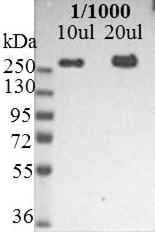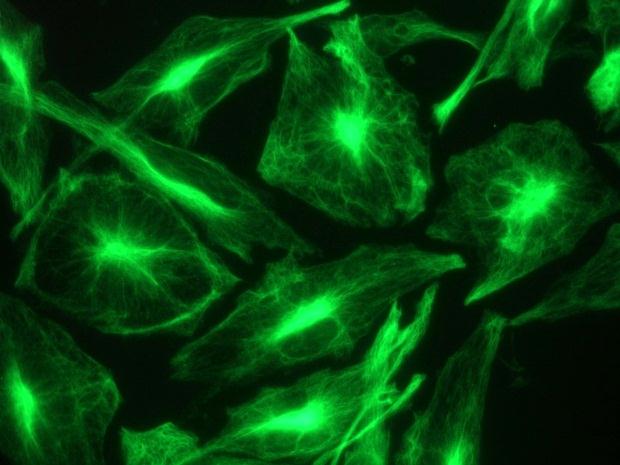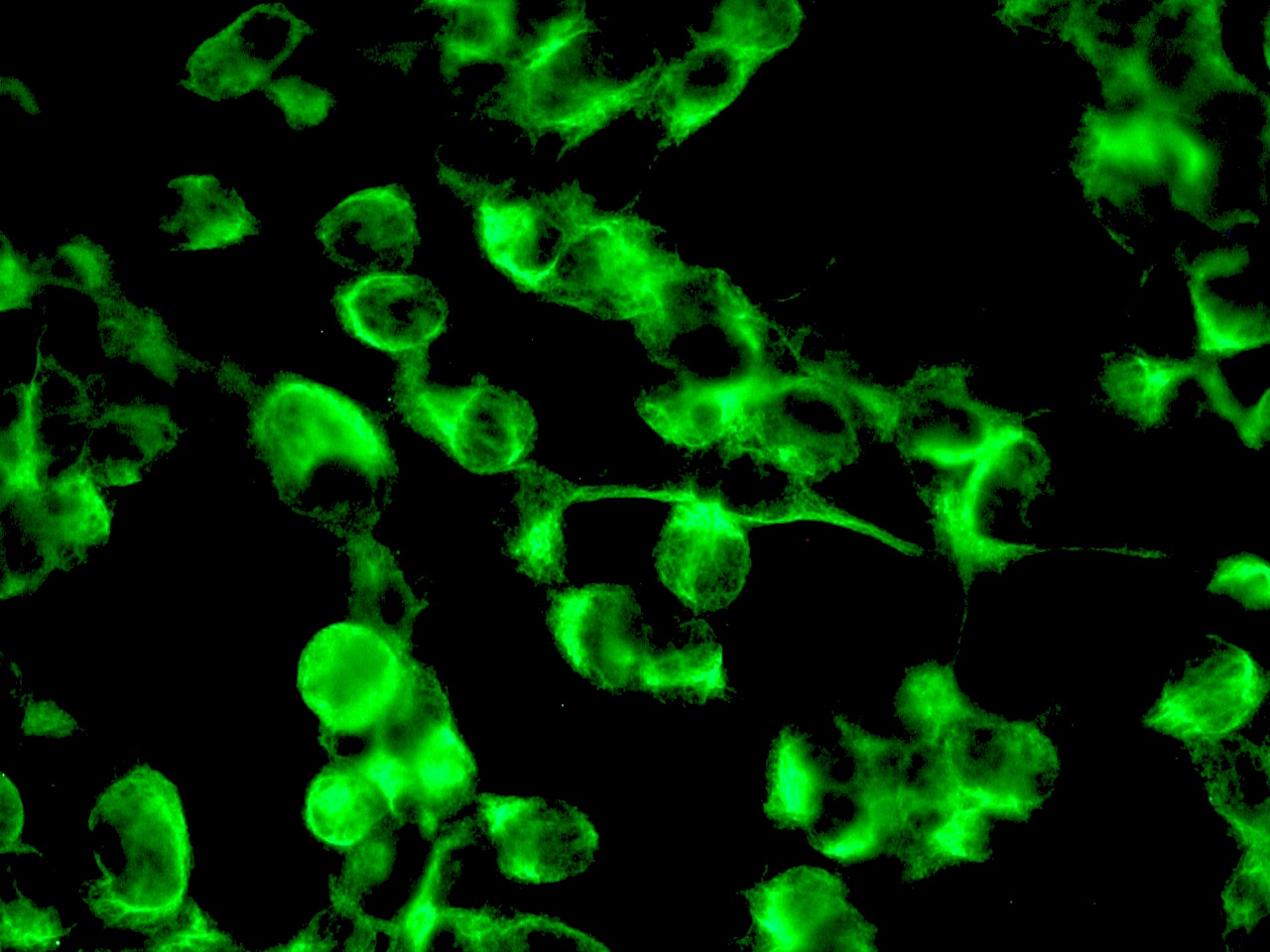Catalogue

Mouse anti Nestin
Catalog number: MUB1302P| Clone | 10C2 |
| Isotype | IgG1 |
| Product Type |
Primary Antibodies |
| Units | 0.1 mg |
| Host | Mouse |
| Species Reactivity |
Human macaque Monkey |
| Application |
Immunocytochemistry Immunohistochemistry (frozen) Immunohistochemistry (paraffin) Western Blotting |
Background
Nestin is a class IV intermediate filament protein abundantly produced in the developing central nervous system (CNS) and in early embryonic neuroepithelial stem cells. This cytoskeletal protein has been widely used as a predominant marker for stem/progenitor cells, glioma cells, and tumor endothelial cells. Also, it is a superior angiogenic marker to evaluate neovascularity of endothelial cells in tumors. This highly specific antibody to human nestin can aid in characterizing progenitor cells differentiating into distinct lineages, in enhancing the therapeutic potential of human neural stem/progenitor cells in the treatment of CNS diseases or injury, and in identifying neuroepithelial tumor cells.
Source
Monoclonal antibody 10C2 was derived by fusion of P3x63Ag8.653 myeloma cells with spleen cells from a BALB/c mouse immunized with a 150-amino-acid fragment from the cloned human nestin, conjugated to glutathione S-transferase.
Product
Each vial contains 100 ul 1 mg/ml purified monoclonal antibody in PBS containing 0.09% sodium azide.
Formulation: Each vial contains 100 ul 1 mg/ml purified monoclonal antibody in PBS containing 0.09% sodium azide.
Specificity
Antibody 10C2 is specific for nestin and suitable for immunoblotting and immunohistochemistry on frozen and paraffin-embedded tissues.
Applications
The 10C2 nestin antibody is useful for immunocytochemistry on fixed cells, immunohistochemistry on frozen and paraffin-embedded tissues, and Western blotting. Optimal antibody dilution should be determined by titration; recommended range is 1:100 to 1:200 for immunocytochemistry and immunohistochemistry with a fluorescein or rhodamine conjugated anti-mouse secondary antibody, and 1:1000 to 1:5000 for Western blot applications using chemoluminescent detection.
Storage
The antibody is shipped at ambient temperature and may be stored at +4°C. For prolonged storage prepare appropriate aliquots and store at or below -20°C. Prior to use, an aliquot is thawed slowly in the dark at ambient temperature, spun down again and used to prepare working dilutions by adding sterile phosphate buffered saline (PBS, pH 7.2). Repeated thawing and freezing should be avoided. Working dilutions should be stored at +4°C, not refrozen, and preferably used the same day. If a slight precipitation occurs upon storage, this should be removed by centrifugation. It will not affect the performance or the concentration of the product.
Caution
This product is intended FOR RESEARCH USE ONLY, and FOR TESTS IN VITRO, not for use in diagnostic or therapeutic procedures involving humans or animals. It may contain hazardous ingredients. Please refer to the Safety Data Sheets (SDS) for additional information and proper handling procedures. Dispose product remainders according to local regulations.This datasheet is as accurate as reasonably achievable, but Nordic-MUbio accepts no liability for any inaccuracies or omissions in this information.
References
1. Messam, C., Hou, J., Major, E.O. (2000). Co-expression of nestin in neural and glial cells in the developing human CNS defined by a human specific anti-nestin antibody. Exp Neurol 161, 585-96.
2.
2. Messam, C., Hou, J., Berman, J.W., Major, E.O. (2002) Analysis of the temporal expression of nestin in human fetal brain derived neuronal and glial progenitor cells. Brain Res Dev Brain Res 134, 87-92.
3.
3. Hou, Y.Y., et al. (2006). Schwannoma of the gastrointestinal tract: a clinicopathological,
immunohistochemical and ultrastructural study of 33 cases. Histopathology 48, 536-45.
4.
4. Mokry, J., Pudil, R., Ehrmann, J., Cizkova, D., Osterreicher, J., Filip, S., Kolar, Z. (2008). Re-expression of nestin in the myocardium of postinfarcted patients. Virchows Arch 453, 33-41.
5.
5. Corsino, P.E., et al. (2008). Mammary tumors initiated by constitutive Cdk2 activation contain an invasive basal-like component. Neoplasia 10, 1240-52.
6.
6. Murphy, A.J., Viero, S., Ho, M., Thorner, P.S. (2009). Diagnostic utility of nestin expression in pediatric tumors in the region of the kidney. Appl Immunohistochem Mol Morphol 17, 517-23.
7.
7. Sellheyer, K., Krahl, D. (2010). Spatiotemporal expression pattern of neuroepithelial stem cell marker nestin suggests a role in dermal homeostasis, neovasculogenesis, and tumor stroma development: a study on embryonic and adult human skin. J Am Acad Dermatol 63, 93-113.
8.
8. Elamin, M.H., et al. (2010). Curcumin inhibits the Sonic Hedgehog signaling pathway and triggers apoptosis in medulloblastoma cells. Mol. Carcinog. 49, 302-14.
9.
9. Popescu, L.M., et al. (2010). Telocytes in human epicardium. J Cell Mol Med 14, 2085-93.
10.
10. Sellheyer, K., Krahl, D. (2011). Does the peritumoral stroma of basal cell carcinoma recapitulate the follicular connective tissue sheath? J Cutan Pathol 38, 551-9.
11. Martínez-Navarrete GC, Angulo A, Martín-Nieto J, Cuenca N. Gradual morphogenesis of retinal neurons in the peripheral retinal margin of adult monkeys and humans. J Comp Neurol. 2008 Dec 1;511(4):557-80. doi: 10.1002/cne.21860.
Safety Datasheet(s) for this product:
| NM_Sodium Azide |

1_MUB1302 Figure 1 Immunoblotting of U251-cell lysate showing reactivity with nestin

Figure 2._MUB1302 Figure 2 Immunostaining of intracellular nestin filaments in U251 cells

Figure 3 Immunostaining of intracellular nestin filaments in cultured SH-SY-5Y neuronal cells using MUB1302P (1:100 dilution).



